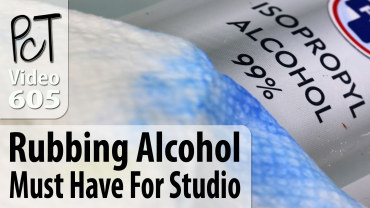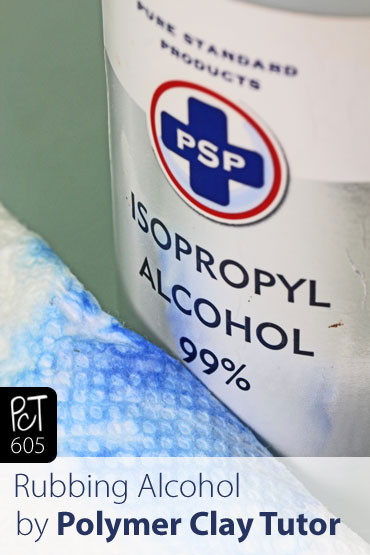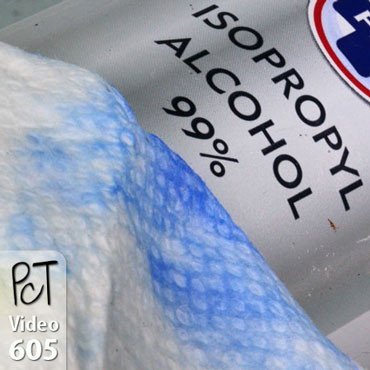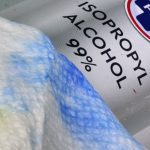Rubbing Alcohol – A Must Have For All Polymer Clayers
Video #605: Isopropyl Alcohol (99%) is one of the most useful supplies to have in your polymer clay studio.
More...
IN THIS POST: —isopropyl alcohol — rubbing alcohol — cleaning clay — remove sharpie inks — remove permanent marker — clean glass — remove stickers — alcohol inks — polymer clay canes — studio supplies — (Topics marked with an asterisk* are discussed in the Comments Section below).
Topics Covered In This Video:
- Rubbing Alcohol (Isopropyl Alcohol 99%) is one of my most useful polymer clay studio supply.
- I use rubbing alcohol for many uses like…
- Cleaning dirty unbaked polymer clay and polymer clay canes…
- Clean tools such as work surfaces, pasta machine, blades, cutters…
- Removing permanent marker (Sharpie) inks…
- Removing stickers from glass and metal…
- Removing dried acrylic paints and finishes…
- If you have a finish that was incompatible with polymer clay (sticky, flaking, peeling), you can soak your polymer clay charms or other pieces in rubbing alcohol to remove the bad finish. Use a toothbrush to scrub recessed areas.
- You can use rubbing alcohol to test paint to see if it is acrylic or oil based. Simply rub any cured swatch of paint that has been applied to any surface, with some rubbing alcohol on a paper towel. If color comes off, then it is a water based paint.
- Thin alcohol inks with rubbing alcohol…
- Clean up Alcohol inks…
- Mix with water and spritz on alcohol ink covered surface for a cool effect…
- Remove sticky residue from UV Resin and UV Gel Nail Polish…
- Clean Glass for adding polymer clay to…
- Clean oil and fingerprints from metal…
- One of the cheapest and most used supplies in my polymer clay studio.
- I purchase 4 bottles of 99% Isopropyl Alcohol in Canada for about $10.
00:00:03 –> 00:00:07 Hi guys, its Cindy Lietz, your Polymer Clay Tutor, and today’s Studio Tip is all about
00:00:08 –> 00:00:14 rubbing alcohol and what a useful tool it is…or supply for your Polymer Clay studio.
00:00:14 –> 00:00:22 Now I use rubbing alcohol all the time, my favorite type is to use the 99% ‘cause it
00:00:22 –> 00:00:27 is the strongest, it is super, super cheap, I bought, I don’t know, 4 bottles…
00:00:27 –> 00:00:34 4 of these size bottles, at Costco for about 5 or 6 bucks, and I use it for all kinds of
00:00:34 –> 00:00:36 things.
00:00:36 –> 00:00:41 First thing you can use it for with Polymer Clay is say you’ve got an old cane that’s
00:00:41 –> 00:00:50 getting beat up and it’s got other colors stuck to it, you can use it to clean the dirty
00:00:50 –> 00:00:55 clay up with the rubbing alcohol, and you can just wipe along, and this is a raw cane
00:00:55 –> 00:01:00 so it hasn’t even been used yet, and I can wipe off all those Pink sections that were
00:01:00 –> 00:01:03 stuck on there and clean it right up.
00:01:03 –> 00:01:07 If you’ve got some White Polymer Clay, you can clean off the dust and the lint by using
00:01:07 –> 00:01:09 rubbing alcohol.
00:01:09 –> 00:01:15 You can also use it to clean your work surfaces, clean your tools, clean your pasta machine,
00:01:15 –> 00:01:23 but it also is a fantastic remover of permanent pen like a Sharpie, so if you’ve got permanent
00:01:23 –> 00:01:28 pen anywhere…except for if it’s soaked in to some paper or some wood or something, sometimes
00:01:28 –> 00:01:34 it’s hard to remove, but if you’ve got permanent pen somewhere else…on a more nonporous surface
00:01:34 –> 00:01:39 and you can’t wipe it off normally, this is just a dry paper towel, I can’t get that off,
00:01:39 –> 00:01:43 but with the rubbing alcohol there, it’ll just wipe right off.
00:01:43 –> 00:01:51 And so to remove Sharpie, it works great for removing stickers on metal objects or glass
00:01:51 –> 00:01:54 objects, if you were gonna cover them with Polymer Clay.
00:01:54 –> 00:02:02 You can also use it to remove excess dried on acrylic paints, and if you’ve got an old
00:02:02 –> 00:02:10 finish, say you’ve used a finish on your Polymer Clay charms and it’s incompatible, it gets
00:02:10 –> 00:02:14 all sticky or it’s flaking off and it’s just not working, you don’t have to throw away
00:02:14 –> 00:02:20 your charm, you can soak it in the rubbing alcohol and you can remove that old finish…you
00:02:20 –> 00:02:24 may need to use a little toothbrush or something to get it worked into the crevices, but you
00:02:24 –> 00:02:29 can usually remove most finishes with rubbing alcohol.
00:02:29 –> 00:02:33 You can also…there’s a neat little trick that painters use if they’re painting the
00:02:33 –> 00:02:39 house, and they can’t tell whether it’s acrylic paint or oil-based paint, you can do something…this
00:02:39 –> 00:02:44 table here has been painted with acrylic, and I can test to see if it’s acrylic paint
00:02:44 –> 00:02:50 by just rubbing some alcohol on it, and if the color comes off, yeah, see the Yellow
00:02:50 –> 00:02:55 there, if the color comes off onto your paper, then you know that it’s an acrylic or water
00:02:55 –> 00:02:57 based paint.
00:02:57 –> 00:03:03 I use it for lots and lots of things, you can thin down your alcohol inks, you can clean
00:03:03 –> 00:03:08 up your alcohol inks, you can also mix it into a bottle with a little bit of water and
00:03:08 –> 00:03:13 spritz it onto alcohol inks and it will bleed out and do some really cool effects.
00:03:13 –> 00:03:21 And, what else do I use it for…it will remove…if you’re using like a UV Gel for your nails
00:03:21 –> 00:03:28 or a UV cured resin, you can wipe it with rubbing alcohol to get that sticky residue
00:03:28 –> 00:03:31 that’s on there after it’s cured, you can remove it with that.
00:03:31 –> 00:03:36 You can also clean glass such as like glass ornaments, if you’re going to be sticking
00:03:36 –> 00:03:42 Polymer Clay on them, you can clean them with rubbing alcohol, same with metal and if you’re
00:03:42 –> 00:03:47 trying to remove grease or fingerprints and that kind of thing, so I find it’s probably
00:03:47 –> 00:03:52 the cheapest but most used supply in my studio.
00:03:52 –> 00:03:57 So I hope that was helpful for you, and if it was, do let us know if you liked this video.
00:03:57 –> 00:04:02 And if you’ve got some other tips for using rubbing alcohol, leave those in the comment
00:04:02 –> 00:04:05 section below, I might have forgotten something.
00:04:05 –> 00:04:12 And if you have suggestions for future videos, things you’d like me to test, products you’d
00:04:12 –> 00:04:15 like me to show you how to use, that kind of thing, leave those in the comment section
00:04:15 –> 00:04:16 below.
00:04:16 –> 00:04:21 And don’t forget we have a great resource over at PolymerClayTutor.com where you can
00:04:21 –> 00:04:26 use the search box to find the answers to all of your Polymer Clay questions.
00:04:26 –> 00:04:27 We’ll see you next time and bye for now.
Our goal is to translate these videos into as many languages as possible. If you are interested in helping with this initiative, then please do contact us and we will figure out a way to make it worth your while :)
Resource Links:
- Related Article: Rubbing Alcohol Uses For Polymer Clay Bead Artists
- Related Video: Cleaning Dirty Polymer Clay That’s Not Baked Yet
- Related Video: Using Rubbing Alcohol To Clean White Clay
- Related Article: Clay Extruder Cleaning and Maintenance Tips
- Amazon: 99% Isopropyl Alcohol (Rubbing Alcohol) **
Resources marked with a double ** asterisk are affiliate links. If you click on them and decide to buy something, we may receive some compensation. This does not affect the price you pay in any way. What it does do, however, is helps us to continue providing free videos for you, here at the PcT website. Using our links to purchase your tools and supplies, is always greatly appreciated.
Sponsored Ads & Special Promotions

Shareable Images



To share this full blog post anywhere on the web that allows links in comments, here's a shortened url to copy and paste...
>> https://mypct.ca/v605 <<

Want to chat about today’s post? That’s what the comment section below is for. Scroll Down… We’d love to hear from you!
Or... if you would like to request a topic for a future post, here is the link to do that… PcT Suggestion Box

Could I use Windex instead of rubbing alcohol. That’s what I happened to have on hand so I cleaned my pasta machine with it.
Thanks,
Nadia
Hi Nadia, Rubbing alcohol works the best for a lot of the things I listed, but if Windex works for you, then certainly use it. I can’t see there being a problem with that.
Thank you so much Cindy. I’m new to polymer clay and love your videos on You Tube! I’ve mastered other art forms and would now like to add polymer clay to my bead embroidered jewelry. I also do Ukrainian eggs and thought the Paisley fit in well with this. If I do well, I will buy the deer sweater pattern tutorial because it to me is very Eastern European. I am in love will detail…the more the better….soooooooo…..we’ll see how I do with the clay. Right now my brain is on overload. I’ve just assembled the items I need from my craft stash and as soon as I get the nerve, I’ll attempt my first clay project.
Look forward to learning more from you. Thanks again.
Joeanna
Thank you for your kind comment Joeanna! You have come to the right place for learning about polymer clay. If you would like to get started off on the right foot, you might want to consider buying the Beginner’s Course. There are 39 videos that will help you to avoid the inevitable mistakes pretty much everyone makes as a beginner… so that you can start making what you love and actually loving what you make.
Here is the link to more info if you’re interested:
Polymer Clay Tutor Beginners Course
Have you done a tutorial on Faux Embroidery ? I am so taken by that look but mine turn out so messy !
Thanks in advance
Tina
Hi Tina, no I haven’t done a tutorial on faux embroidery yet. It would make a good tutorial though… I’ll have to add it to the list!